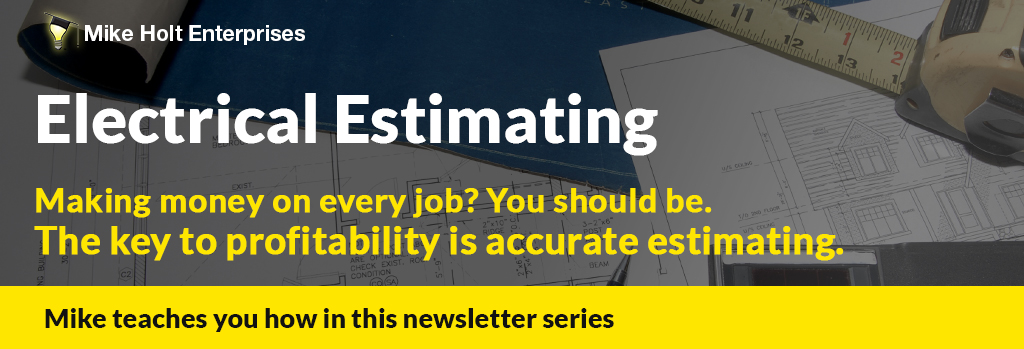|
 As part of my ongoing effort to provide free resources for the electrical industry I want to share with you my methodology for electrical estimating. This is a skill that can make or break a career, and make or break a company, and I want to help you understand the estimating and bidding processes so that your business can be profitable. As part of my ongoing effort to provide free resources for the electrical industry I want to share with you my methodology for electrical estimating. This is a skill that can make or break a career, and make or break a company, and I want to help you understand the estimating and bidding processes so that your business can be profitable.
In this monthly newsletter series on electrical estimating, I'll explain how to determine the material cost, labor cost, and the calculation of direct job costs, overhead and profit, so that you know going into a job how you can avoid failure - which in some cases might mean not taking the job!

The following content is extracted from Mike Holt's Guide to Electrical Estimating.
|
About Estimating - Part 1 |
| About Estimating - Introduction |
Now that you understand the important role that estimating plays in the electrical industry and in your company, you are ready to learn more about the process. You'll need to understand the responsibilities of an estimator and what resources are needed to meet those responsibilities.
| 2.1 Qualities of a Good Estimator |
The following is a list of qualities that identify a good estimator:
- A positive mental attitude
- Computer literacy
- A willingness to learn from one's mistakes
- Familiarity with new products and installation methods
- An understanding of construction and the ability to visualize the electrical requirements
- An orderly mind with a tendency to be careful, accurate, and neat
- Decisiveness and the ability to make decisions without being intimidated by details
- Fairness, honesty, and integrity
- Knowledge of the National Electrical Code and local electrical codes
- Patience to finish the estimate without frustration
- Organization
- A willingness to stick to and get the job done by putting in whatever time is necessary to meet the bid date and time deadlines
| 2.2 The Estimating Workspace and Tools |
The Workspace
Before you even think of estimating a job, you need to have the proper workspace and tools. Appropriate lighting is essential. The workspace must be laid out efficiently and be located where the estimator will not be disturbed. It needs to be of adequate size, not just a closet with a desk. Many business managers try to save money in this regard, only to lower the productivity of the estimators and thereby raise the cost of doing business. The workspace should be designed so that everything is within reach from the sitting position, including books, paperwork, telephone, fax machine, computer, and so forth.
Estimating Tools
We all know that performing a job without the proper tools often gives poor results, causes frustration, and takes longer than necessary. Proper estimating tools reduce human errors, increase efficiency, and quickly pay for themselves. The estimator should have the following tools in proper condition:
Adding Machine. Get a large adding machine or printing calculator with large keys and a paper printer or history feature. These are helpful for running quick totals to check your counts or calculations.
Aspirin. You will need them.
Bookcases. Bookcases are a must to hold reference materials such as catalogs, literature, and manuals from manufacturers and electrical distributors, and a rack or two for DVDs and CDs.
Chair. Many estimators prefer to work with an adjustable height swivel chair between two large ta-bles, or between a table and a desk to permit the most efficient use of the workspace. A comfortable chair that rolls and has armrests is a requirement, so do not try to save any money here”a properly fitted chair will pay for itself many times over.
Colored Pencils, Pens, or Highlighters. You will need colored pencils, pens, or fine- and large-tip highlighters to mark symbols on any printouts of the drawings.
Computer. Be sure you have adequate computer resources including spreadsheet and word processing programs. Remember that time is money. If an employee has to wait for the computer to do a normal task it causes frustration and inefficiency, and costs money. A fast internet connection is a must to save time in looking up information, contacting customers and suppliers, and doing needed research. An email account is required, not optional, and make sure you have one that uses your company name, rather than using an unprofessional personal email address.
Copy Machine. A copy machine is always needed, but you should purchase a multi-function copy/print/fax machine that is dedicated to the estimator's space to make copies, scans, and to send and receive faxes. Consider a scanner with a double sided ADF (automatic document feeder) so both sides of multiple pages can be easily scanned.
Counter. The counter is designed to be used to track the number of an item you are counting on a plan sheet. Most estimating software has a counter feature that works from the keyboard or mouse and there are also separate devices that can do a simple count for a quick estimate and interface with your estimating software for instant data input.
Desk. A large desk is necessary to have an adequate work area for paperwork, pencils, pens, mouse, keyboard, and everything else that seems to accumulate. A small work area will force you to continuously struggle to keep things organized and will waste valuable time.
Digital Plan Wheel and Counter. A digital drawing wheel is used to measure circuit run lengths and has an electronic counter built in. A digital drawing wheel has the ability to change the scale quickly and is very easy to read and use. These devices also contain a counter feature and can interface with your estimating software.
Draftsman's Measuring Tape. A measuring tape that has a 18 in. and a 1/4 in. scale is a great backup to a digital plan wheel.
Filing Cabinets. While it is easier to find and share things that have been converted from paper to an electronic format, it also takes time to scan things. In some cases, it is still more efficient to keep project related papers and plan packages in filing cabinets.
Lighting. Get plenty of light for the work surface area; a nice desk lamp and good overhead lighting is never a bad idea.
Magnifying Glass. Some details on paper drawings might be difficult to decipher without a magnifying glass. A pair of reading glasses might achieve the same effect hands-free.
Mechanical Pencils. Use a good mechanical pencil with 0.07 lead and an eraser.
Monitors. Large high-resolution monitors are a great help when working on spreadsheets, digital plans or project documentation. Two displays side by side allow several project documents to be open for reference simultaneously.
Headphones. Noise cancelling headphones with music can help some people focus as they spend hours and hours estimating in an office environment.
Plan Table. Since you may be required to work with paper prints, you need an inclined drawing table with enough space to lay the prints out flat. The table should have an edge on the bottom to keep the prints from sliding off. It should be able to be used from the desk chair without being raised or lowered.
Plan Racks. Plan racks are used to store drawings and help keep the work area organized. You can make drawing racks yourself that can hold both the drawings and appropriate specifications together.
Printer. A laser printer that prints double-sided can save a lot of paper when printing copies of quotes and specifications. In today's construction industry project drawings and specifications are often being distributed electronically and you will have the task of downloading and printing them. Use local or online printing services that provide an easy way to upload plans and fast delivery to avoid the need to purchase expensive plotters.
Scale Ruler. Make sure you have an architectural scale ruler that is based on inches. While not essential, an engineering ruler will make quick measurements from paper civil or site drawings easier and more precise.
Software. Good estimating software will take some time to become comfortable with and to master. The amount of time it takes to become adept at using a particular program depends on its complexity and how much time you spend actually using it. The estimated cost for this type of software varies by type and purpose.
Telephone and Fax Capabilities. The phone line should be a discreet number for use only by the estimating department. The same holds true for fax capabilities.
Wall Space. A large clear wall in front of your drafting table is convenient for posting important information about the project but keep this to a minimum or you will end up with clutter.
Whiteboard. A whiteboard can be used for many functions such as scheduling, keeping track of jobs, and so forth. Even if you have a paperless office, such a board is helpful for discussions, temporary notes, and other transient communication activities.
We'd love to hear from you about this series, and the ways you're using it. Send us your comments and feedback by clicking on Post a Comment below. Look out for the next part in this series a month from now, and please share with your colleagues.
This content is extracted from Mike Holt's Guide to Electrical Estimating textbook.
To review or catch up on previous newsletters on Management and Business click here
|

